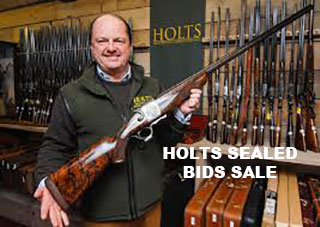A hundred years ago, British gun-making was, rather like the British Empire, at the height of its powers. However, storm clouds were gathering for both entities.
The end of the Great War heralded major societal change and alterations to the long-held social orders that had bound the country together, with strict hierarchies from estate to parish, to county to nation.
The Wall Street Crash was less than a decade away and the start of the next war a decade further into the future. The inter-war years, for the fortunate in British society must have seemed charmed. The Brideshead Revisited generation basked in the sunset of British global dominance for a few, short, perhaps, glorious years.
While the Empire prospered, so did the gun trade. Birmingham fed the mass market and (less transparently) enabled the famed London makers to fulfil their orders, while also securing overseas trade deals with American companies and exporting to the colonies.
The British sporting gun by 1922 was, essentially, perfected. All the significant mechanisms we know today were already well known and available. The side-lock ejector was the standard British ‘best’ gun, with the top firms each having their own, well recognised, model at the head of their listing. Purdey with the Beesley action self-opener, Holland & Holland with the ‘Royal’ assisted opener, Boss with their graceful side-locks also stood apart. Westley Richards offered their, Taylor patent, hand-detachable locks and variants of their Anson & Deeley action were widespread.
The over & under was also established, with the Woodward and Boss variants already perfected. As well as gun actions and aesthetic ideas set, major mechanical niceties were, by then, settled. Holland’s ‘A-B’ ejector, Boss coil-spring ejectors, single triggers, chopper-lump barrels, intercepting safeties; the best designs were by now settled and most had out-lived their patent protections and were available to be made by anyone.
Prosperous firms in the British gun trade were legion. The quality of workmanship was incredible; many gunmakers apprenticed when specialisation and bench-craft were at the height of their powers.
An experienced gunmaker in 1922, aged fifty, would have started his apprenticeship in 1887 and finished it in 1894. Those were days in which gunmakers stayed in their jobs from fifteen years old, often, until they died. The bank of skills and knowledge was at its peak. No wonder guns from this period are so beautifully made. No wonder we are still buying them at auction and using them!
The British Gunmaker Today
The Empire has gone, the customers are different, mechanisation has revolutionised gun-making, the number of British gun-makers has been reduced to a handful of firms. The Birmingham Gun quarter has largely disappeared under a ring-road, London firms have been bought by huge international brands; Purdey by Richemont, Rigby by L&O, Holland & Holland (until recently owned by Chanel, now part of Beretta Holdings).
In Birmingham, Westley Richards has foreign investment securing its future. Only Dickson and Boss remain in private (the latter, American) ownership, making guns the traditional way. Outside the major cities, Atkin Grant & Lang, William Powell and a small number of small gunmakers or sellers still ply their trade.

The Image of Shooting Sports
The kind of magazine that is read by the public for general interest used to, quite often, feature stories of hunters, safaris or stirring tales of adventure, in which the chap with the rifle is the hero and the savage beast is the force of nature to be overcome.
Now, we live in an age of nature under threat and men with guns are seen as destructive, wanton and cruel. There is a constant public relations battle being fought between the shooting sports advocates and the wider community, by which hunting and shooting are overwhelmingly viewed negatively.
Environmental, political and legal challenges.
The very essence of gun-making and shooting is undergoing radical change. Bullets, shot, wadding, cartridge cases and even clay targets are having to be re-manufactured using material considered less polluting or toxic. The guns and rifles our gunmakers build have to be capable of delivering top performance with substitutes; mostly copper in the case of bullets and steel as a lead-shot replacement.
This is being done in a political environment in which shooting is increasingly being edged-out of the normal range of sporting activities. The rearing and release of game birds is under attack, the land available for shooting is being reduced, with large land-holders, like the Forestry Commission and local councils submitting to pressure to ban shooting and hunting on their forests, moors, shore lines and reserves.
Africa, the engine driving double rifle and large calibre bolt-rifle sales, is under increasing pressure. Big game hunting is becoming rapidly less socially acceptable outside die-hard shooting community opinion. That political pressure may-well ensure the continued decline of the hunting industry there.
There is the added pressure of land use conflict, the rising influence of Chinese and Indian companies, with very different agendas to the western-led conservation hunting models used promoted in Africa.
There is also the tipping point of fatigue to consider - how long will hunters struggle against all the pressures on them: firearms regulation, ammunition restriction, airlines declining to fly firearms, governments refusing to import trophies, the rising cost of trophy hunting and the peer pressure from friends, family and employers, all of which become increasingly burdensome. Without a new generation of hunters and gun buyers, the mid-to-long term prospects for gun-makers look challenging.
None of this bodes well for makers or sellers of high quality, expensive hunting rifles and shotguns.
The Products
British gunmakers today have to decide what niche they wish to fill. 2021 is a very different world to that of 1921. Boss take the route of no expense spared, traditional hand-craft only, exclusive, bespoke; and unattainable to all but the select few.
Rigby attacked the middle market first, producing bolt-action rifles targeting the aspirational, but affordable, luxury for the middle-class hunter. To that they have added higher-grade products to tempt the more affluent, with rising-bite double rifles and shotguns.
Purdey side-locks have doubled in price in a decade. They have introduced some lower-cost models; bolt-action rifles and over & under shotguns. If price inflation is their mechanism for maintaining profitability, is a standard new Purdey going to cost £300,000 ten years from now? If so, who is going to buy one?

Holland & Holland also introduced lower-priced shotguns and currently have about nine million pounds worth of stock built that needs to sell, while new orders are not keeping up with the financial demands of running factory and company. Where will they pitch themselves in the years to come - will they fight for the top end of the trade or try harder to compete in a wider market by offering more, lower priced models? Chasing the mass market is tempting but it could destroy the brand value.
The motivation for most people buying a new British gun is involvement in the process. Why would anyone buy a new Purdey for £140,000 when you can buy an immaculate used one for £50,000? The difference is that involvement.
Today’s customer is a rich enthusiast with the means to indulge himself, playing at creating his ideal. He is commissioning a gun or rifle for the love of the process, the relationship with the gun-maker, his place in history and the time creatively spent discussing every minor aspect of the build. Build a gun for stock and put it on the shelf and he feels like he is shopping in Top Man rather than on Saville Row.
Are Britain’s last few remaining gunmakers going to find their future prosperity as competitors with Spanish and Italian makers, increasing the use of machinery and bringing prices down? At what point does a premium brand lose its cachet? Or, can we expect to see them double down on the high prices, competing for the super-rich man’s dollar only?
Some are getting it right. Rigby and Westley Richards are both run as tight ships and the relationships the managing directors have with their clients are key to their profitability. Making money selling new English guns is a tough task; but it can be done.

The customers - collecting and mortality.
It has long been observed that the average gun buyer is not a young man. Collectors tend to be well over fifty and most of the top collectors currently active are in their seventies.
Unless put into private trusts for display, these collections will be entering the market in the next ten or fifteen years. When a market is awash with certain products, their price drops. When the cheap second-hand goods are very similar to new ones, the lure of the used market will undermine the makers trying to sell new kit, especially off the shelf kit.
Take a look on Gun Trader. There are currently plenty of immaculate Purdey over & unders for sale at £70,000 lower than current cost and they have been looking for buyers for a long time.
Rigby sold about a thousand (mostly bolt-action) rifles in the first seven years of its re-introduction to London. What is saturation point for this kind of thing? As these begin to hit the used market, as they will over the next decade, how will that impact the desire to buy new? What is the worldwide capacity for demand for a £6,000 Rigby .416? The company has done incredibly to date but the job gets harder with every new sale.

As has long been known, the life span of British guns is a rod with which fortune beats the maker. Unlike luxury cars, you don’t buy a new rifle or shotgun every three to five years. One is likely to serve three generations, if necessary.
The auctioneers trade alongside the gun makers, feeding off their past glories and benefitting from any success they are currently enjoying. When Purdey or Rigby drive a successful campaign and demand and appreciation follows, Holt’s and Bonham’s reap the rewards in increased prices and demand for the used or historic guns and rifles by those firms that go through the sale rooms.
In the post-COVID world, our premier gun makers face some huge challenges. Whatever they do will be reflected in auction activity in one way or another, a year or a decade, later.

Published by Vintage Guns Ltd on




